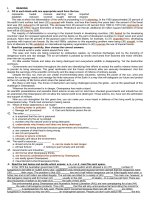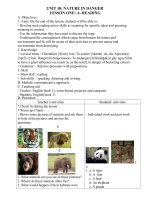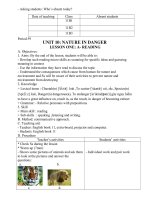Unit 10 Reading Nature in danger
Bạn đang xem bản rút gọn của tài liệu. Xem và tải ngay bản đầy đủ của tài liệu tại đây (1.66 MB, 4 trang )
<span class='text_page_counter'>(1)</span>Unit 10 Nature in danger Lesson one : Reading A. Objectives 1. Aims: By the end of the lesson, the students will be able to: - Develop reading skill as scanning for main ideas and gessing meaning in context. - Use the information they have read to discuss environmental destruction and conservation. - Understand the serious consequences of people's interference with nature and environment and students will be aware of their activities to prevent nature and environment from destroying. 2. Knowledge: - list some new words related to the Nature in danger. - Develop comprehensive reading skill. - Become more excited about activities to project nature and environment from destroying. 3. Skill: - Main skill : reading - Sub-skills : speaking ,listening and writing. B. Method: communicative approach. C. Teaching aid: - English book 11, using visuals, projector and computer. Procedure Stages/ timing. Teacher’s activities. Students’ activities. Warm up:. - Shows some pictures of animals and ask Students to look at the pictures and answer the questions:. 5mins. A. B. C D 1. Have you ever seen animals in these pictures ? 2. Where did you see it ? 3. Do you like it? 4. Where do these animals often live? -They often in the the forests, zoos or National Parks.. - Individual work and pair work - Look at these picture and answer the questions:.
<span class='text_page_counter'>(2)</span> I. Before you read. - Ask students to open their book and ask them to read the fact about endangered species and answer the questions:. - Pair work - Read books and answer the questions - Read loudly their answer before class. 5mins 1. Do you think animals in these picture become extinct? 2. Can you explain why animals becomes extinct ? Answer: 1. Animals become extinct/ small. 2. Animals becomes extinct because they are killed for food, fur or skin. Ask students look at these pictures on the projector and answer the questions: II. While you read 4 mins. 3mins. 6mins. 1. What are these ways by which human being are changing the world ? Answer: - Cuting down tree - Smoke from vehicles - kill animals for food.. - Pair work: answer the questions. - Read loudly their answer before class. Vocabulary: Exist (v) : Live Co-Exist (v) : Live the same time Consequence (n) :Result (usually bad) Extinct( adj) : No longer living Prohibit (v) : Express the idea of saying that sb mustn't do sth Off-spring: Young of the animal. - Individual work Students find the position of the words in the box end then give the Vietnamese equivalent of each words.. Task 1: - Ask students to scan the passage to find the position of the words in the box. - Ask students to guess the Vietnamese equivalent of each words (help them if necessary). - Have students 4 mins to work individually to fill the blank with the. - Individual Some students to speak out their answer before class..
<span class='text_page_counter'>(3)</span> words given - Call some students to speak out their answer before class. Give corect answers: 1. extinct 3. decreasing 5. endanger 2. protect 4. pollutants 6.interference. 4mins. 7mins. Task 2: - Ask students to divide in 4 groups. Give corect answers: 1. C 2. B 3. A 4. C. Task 3: - Ask student to read the text again and answer the questions - Call on some student stand up and do exercise. 1. Four ways that people change the world are: - They are changing the environment by building cities and villages - They are affecting the water supply by using water for industry and agriculture - They are changing weather condition by cutting down trees in the forests - They are destroying the air by adding pollutants like smoke from factories and fumes from cars. 2. The serious consequences of people’s interference with the environment are: - many kinds of rare animals are killed - the environment where these animals are living is badly destroyed - the numbers of rare animals are decreasing so rapidly that they are in danger of becoming extinct 3. Many things have been done to protect endangered nature, such as: - Many organizations have been set up. - Work in group Group 1: To scan the paragrap 1 and then give corect number 1. Group 2: To scan the paragrap 2 and then give corect number 2. Group 3: To scan the paragrap 3 and then give corect number 3. Group 4: To scan the paragrap 4 and then give corect number 4.. -Pair work Answer the questions. Some students to speak out their answer before class..
<span class='text_page_counter'>(4)</span> and money has been raised to save rare animals - thousands of national parks have been established - laws have been passed to prohibit killing endangered animals III. After you read. - Ask student to work in group to find out why some animals have become extinct - Call on some students to speak out their ideas. 4mins. - People kill animals for fur, skin and food - People keep animals as pets people hunt or capture - Animals for recreation or entertainment. IV. Home work 1mins. - Work in group Some students to speak out their answer before class.. - Summarises the main point of the lesson - Ask students to learn by heart the new words - Ask students find some animals becomes - Listen and write on the notebook extinct and give methold to protect them..
<span class='text_page_counter'>(5)</span>









